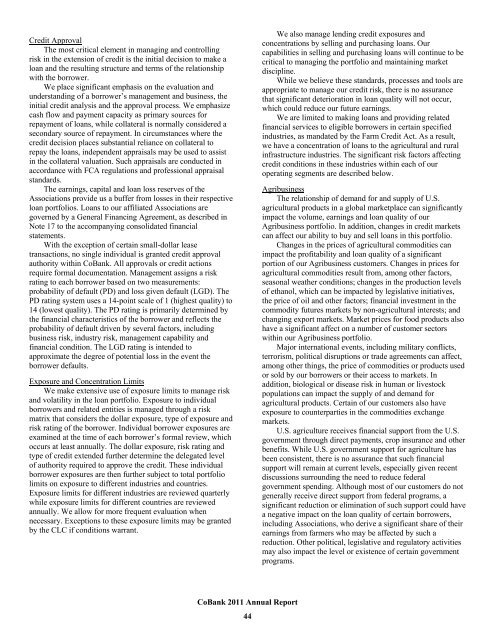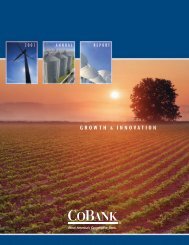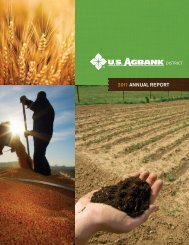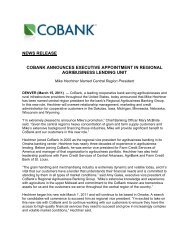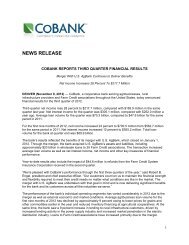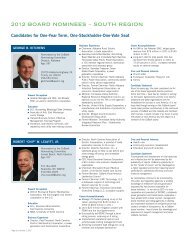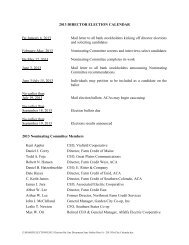Corporate Risk ProfileManaging enterprise risk is an essential part ofsuccessfully operating our Bank. Our primary risk exposuresare credit, interest rate, liquidity, operational and reputation.Credit risk is the risk of not collecting the amounts due onloans, investments or derivatives. Interest rate risk is thepotential reduction of net interest income and the market valueof equity as a result of changes in interest rates. Liquidity riskis the potential inability to repay obligations or fund borrowerson a timely basis. Operational risk is the risk of loss resultingfrom inadequate or failed processes or systems, breaches ofinternal controls or compliance requirements, the risk of fraud,and other operational matters. Reputation risk is the risk ofloss arising from negative public opinion.Business segments have the responsibility of identifying,controlling and monitoring risks. Our Risk ManagementGroup provides oversight of the Bank’s enterprise-wide riskmanagement through measurement and control processesaddressing all of the Bank’s primary risk exposures, includingcredit, interest rate, liquidity, operational and reputation. Thefollowing is a discussion of these risks, and our approach tomanaging them.Credit Risk ManagementCredit risk exists in our lending, investing and derivativesactivities. Credit risk in lending arises from changes in aborrower’s ability to repay funds borrowed, changes incollateral values, and changes in industry and economicconditions. Credit risk in our investment portfolio primarilyresults from changes in residential real estate values, defaultrates on collateral underlying mortgage-backed and assetbackedsecurities, and the credit worthiness of bond insurerswho insure certain of our investment securities. Credit risk inour derivatives portfolio results from changes in a derivativecounterparty’s ability to perform under the contract terms.We actively manage credit risk through a well-defined,Board-approved portfolio strategy, a structured and centralizedcredit approval process, a disciplined risk managementprocess, and a sound credit administration program. We haveestablished comprehensive credit guidelines and procedures toensure consistency and integrity of information related to thecredit risk in our loan, investment and derivatives portfolios.Various groups and committees within <strong>CoBank</strong>, includingour Board of Directors, have a role in managing credit risk, asdescribed below. Our Board of Directors establishes overalllending, investment and reserve policies. It also approves theloan portfolio strategy and reviews loan volume, loan qualitytrends, significant high-concern or troubled loans, and thecredit quality of our investment and derivatives portfolios.The <strong>CoBank</strong> Loan Committee (CLC), which is appointedby the President and CEO, and includes the Chief CreditOfficer and senior management of the Credit Group and thelending groups, holds ultimate credit authority as authorizedby Board policy. The CLC delegates lending authorities tospecific committees based on size of exposure and risk rating,and approves limits for investment obligors and derivativecounterparties. It acts on individual credit actions oradministrative matters and approves exceptions to exposurelimits if conditions warrant.The Credit Group is led by the Chief Credit Officer, whoreports to the President and CEO. The Credit Group managesthe credit approval process within concentration limitsestablished for the loan portfolio pursuant to Board policies.As part of the credit approval process, it reviews assigned riskratings for accuracy and conformity with our establishedguidelines, and recommends limits with respect to investmentobligors and derivative counterparties. It also managessignificant high-risk or troubled loans.The Risk Management Group is led by the Chief RiskOfficer, who reports to the President and CEO (with certainindividuals within this group having direct reportingresponsibility to the Audit Committee and the Board ofDirectors). The Risk Management Group overseesdevelopment of the loan portfolio strategy, the analysis of thereserve for credit exposure, and economic capital. It providesindependent reporting to the Board of Directors on the qualityof the Bank’s assets, the Bank’s system of internal controls,and material findings of the Asset Review and Internal AuditDivisions.The Asset and Liability Committee (ALCO), whichincludes the President and CEO, Chief Banking Officer, ChiefOperating Officer, Chief Financial Officer, Chief Risk Officer,Chief Credit Officer and Treasurer, oversees credit risk withinthe investment portfolio. It also reviews counterparty creditrisk arising from derivative transactions.Credit Risk Related to LoansThe key elements of our credit risk management related tolending include our portfolio strategy, the credit approvalprocess, and the use of exposure and concentration limits,which are explained below.Portfolio StrategyAs part of the annual business and financial planningprocess, the Board of Directors reviews and approves theBank’s loan portfolio strategy. Management regularlyanalyzes performance with respect to the portfolio strategyand reports the results to the Board of Directors. Theobjectives of our portfolio strategy are to safely fulfill ourlending mission to our customers, ensure appropriate portfoliodiversification, and optimize returns based on risk andprofitability, all within established capital parameters.<strong>CoBank</strong> 2011 <strong>Annual</strong> <strong>Report</strong>43
Credit ApprovalThe most critical element in managing and controllingrisk in the extension of credit is the initial decision to make aloan and the resulting structure and terms of the relationshipwith the borrower.We place significant emphasis on the evaluation andunderstanding of a borrower’s management and business, theinitial credit analysis and the approval process. We emphasizecash flow and payment capacity as primary sources forrepayment of loans, while collateral is normally considered asecondary source of repayment. In circumstances where thecredit decision places substantial reliance on collateral torepay the loans, independent appraisals may be used to assistin the collateral valuation. Such appraisals are conducted inaccordance with FCA regulations and professional appraisalstandards.The earnings, capital and loan loss reserves of theAssociations provide us a buffer from losses in their respectiveloan portfolios. Loans to our affiliated Associations aregoverned by a General Financing Agreement, as described inNote 17 to the accompanying consolidated financialstatements.With the exception of certain small-dollar leasetransactions, no single individual is granted credit approvalauthority within <strong>CoBank</strong>. All approvals or credit actionsrequire formal documentation. Management assigns a riskrating to each borrower based on two measurements:probability of default (PD) and loss given default (LGD). ThePD rating system uses a 14-point scale of 1 (highest quality) to14 (lowest quality). The PD rating is primarily determined bythe financial characteristics of the borrower and reflects theprobability of default driven by several factors, includingbusiness risk, industry risk, management capability andfinancial condition. The LGD rating is intended toapproximate the degree of potential loss in the event theborrower defaults.Exposure and Concentration LimitsWe make extensive use of exposure limits to manage riskand volatility in the loan portfolio. Exposure to individualborrowers and related entities is managed through a riskmatrix that considers the dollar exposure, type of exposure andrisk rating of the borrower. Individual borrower exposures areexamined at the time of each borrower’s formal review, whichoccurs at least annually. The dollar exposure, risk rating andtype of credit extended further determine the delegated levelof authority required to approve the credit. These individualborrower exposures are then further subject to total portfoliolimits on exposure to different industries and countries.Exposure limits for different industries are reviewed quarterlywhile exposure limits for different countries are reviewedannually. We allow for more frequent evaluation whennecessary. Exceptions to these exposure limits may be grantedby the CLC if conditions warrant.We also manage lending credit exposures andconcentrations by selling and purchasing loans. Ourcapabilities in selling and purchasing loans will continue to becritical to managing the portfolio and maintaining marketdiscipline.While we believe these standards, processes and tools areappropriate to manage our credit risk, there is no assurancethat significant deterioration in loan quality will not occur,which could reduce our future earnings.We are limited to making loans and providing relatedfinancial services to eligible borrowers in certain specifiedindustries, as mandated by the Farm Credit Act. As a result,we have a concentration of loans to the agricultural and ruralinfrastructure industries. The significant risk factors affectingcredit conditions in these industries within each of ouroperating segments are described below.AgribusinessThe relationship of demand for and supply of U.S.agricultural products in a global marketplace can significantlyimpact the volume, earnings and loan quality of ourAgribusiness portfolio. In addition, changes in credit marketscan affect our ability to buy and sell loans in this portfolio.Changes in the prices of agricultural commodities canimpact the profitability and loan quality of a significantportion of our Agribusiness customers. Changes in prices foragricultural commodities result from, among other factors,seasonal weather conditions; changes in the production levelsof ethanol, which can be impacted by legislative initiatives,the price of oil and other factors; financial investment in thecommodity futures markets by non-agricultural interests; andchanging export markets. Market prices for food products alsohave a significant affect on a number of customer sectorswithin our Agribusiness portfolio.Major international events, including military conflicts,terrorism, political disruptions or trade agreements can affect,among other things, the price of commodities or products usedor sold by our borrowers or their access to markets. Inaddition, biological or disease risk in human or livestockpopulations can impact the supply of and demand foragricultural products. Certain of our customers also haveexposure to counterparties in the commodities exchangemarkets.U.S. agriculture receives financial support from the U.S.government through direct payments, crop insurance and otherbenefits. While U.S. government support for agriculture hasbeen consistent, there is no assurance that such financialsupport will remain at current levels, especially given recentdiscussions surrounding the need to reduce federalgovernment spending. Although most of our customers do notgenerally receive direct support from federal programs, asignificant reduction or elimination of such support could havea negative impact on the loan quality of certain borrowers,including Associations, who derive a significant share of theirearnings from farmers who may be affected by such areduction. Other political, legislative and regulatory activitiesmay also impact the level or existence of certain governmentprograms.<strong>CoBank</strong> 2011 <strong>Annual</strong> <strong>Report</strong>44
- Page 4 and 5: Everett DobrinskiChairmanRobert B.
- Page 6 and 7: “ We firmly believe the combined
- Page 8 and 9: associations are partnering with Co
- Page 11 and 12: 2012 BOARD OF DIRECTORSOccupation:F
- Page 13 and 14: “WE ARE COMMITTEDTO GOOD GOVERNAN
- Page 15 and 16: U.S. AgBank CEO Darryl Rhodes (fron
- Page 17 and 18: KansasNew MexicoUtahFC of Ness City
- Page 19 and 20: CorporateCitizenshipAT COBANKSuppor
- Page 21 and 22: StrategicRelationshipsFarm Credit o
- Page 23 and 24: RegionalAgribusinessBANKING GROUPCe
- Page 25 and 26: CorporateAgribusinessBANKING GROUPK
- Page 27 and 28: ElectricDistributionBANKING DIVISIO
- Page 29 and 30: Power SupplyBANKING DIVISIONTri-Sta
- Page 31 and 32: IndustryPortfoliosCoBank ended 2011
- Page 33 and 34: CoBank is a financially strong,depe
- Page 35 and 36: 30COBANK 2011ANNUAL REPORTbuilding
- Page 37 and 38: The information and disclosures con
- Page 39 and 40: Financial Condition andResults of O
- Page 41 and 42: Provision for Loan Losses and Reser
- Page 43 and 44: Purchased services expense decrease
- Page 45 and 46: AgribusinessOverviewThe Agribusines
- Page 47: Rural InfrastructureOverviewThe Rur
- Page 51 and 52: Total nonaccrual loans were $134.9
- Page 53 and 54: Basis RiskBasis risk arises due to
- Page 55 and 56: Our net interest income is lower in
- Page 57 and 58: The notional amount of our derivati
- Page 59 and 60: Reputation Risk ManagementReputatio
- Page 61 and 62: Investment Securities ($ in Million
- Page 63 and 64: In accordance with the Farm Credit
- Page 65 and 66: Critical Accounting EstimatesManage
- Page 67 and 68: Business OutlookWe closed our merge
- Page 69 and 70: Consolidated Income StatementsCoBan
- Page 71 and 72: Consolidated Statements of Cash Flo
- Page 73 and 74: Consolidated Statements of Changes
- Page 75 and 76: LoansWe report loans, excluding lea
- Page 77 and 78: If we determine that a derivative n
- Page 79 and 80: Reserve for Credit ExposureThe foll
- Page 81 and 82: The information in the tables under
- Page 83 and 84: The following tables present inform
- Page 85 and 86: At December 31, 2011, gross minimum
- Page 87 and 88: For impaired investment securities,
- Page 89 and 90: At December 31, 2011, the assets of
- Page 91 and 92: Preferred StockThe following table
- Page 93 and 94: The following table provides a summ
- Page 95 and 96: AssumptionsWe measure plan obligati
- Page 97 and 98: Incentive Compensation PlansWe have
- Page 99 and 100:
Note 11 - Derivative FinancialInstr
- Page 101 and 102:
A summary of the impact of derivati
- Page 103 and 104:
Due to the uncertainty of expected
- Page 105 and 106:
Assets and Liabilities Measured atF
- Page 107 and 108:
Note 14 - Segment Financial Informa
- Page 109 and 110:
Note 15 - Commitments and Contingen
- Page 111 and 112:
Note 18 - Subsequent Events (Unaudi
- Page 113 and 114:
Supplemental District Financial Inf
- Page 115 and 116:
Supplemental District Financial Inf
- Page 117 and 118:
Report of Independent AuditorsCoBan
- Page 119 and 120:
Management’s Report on Internal C
- Page 121 and 122:
Annual Report to Shareholders Discl
- Page 123 and 124:
Board of Directors Disclosure as of
- Page 125 and 126:
Board of Directors Disclosure as of
- Page 127 and 128:
Board of Directors Disclosure as of
- Page 129 and 130:
Board of Directors Disclosure as of
- Page 131 and 132:
Senior OfficersCoBank, ACBRobert B.
- Page 133 and 134:
Senior Officers Compensation Discus
- Page 135 and 136:
Senior Officers Compensation Discus
- Page 137 and 138:
Senior Officers Compensation Discus
- Page 139 and 140:
Senior Officers Compensation Discus
- Page 141 and 142:
Senior Officers Compensation Discus
- Page 143 and 144:
Senior Officers Compensation Discus
- Page 145 and 146:
Code of EthicsCoBank, ACBCoBank set
- Page 147 and 148:
CERTIFICATIONI, Robert B. Engel, Pr
- Page 149 and 150:
LeadershipCoBank, ACBRobert B. Enge
- Page 151 and 152:
OfficeLocationsCoBank National Offi


